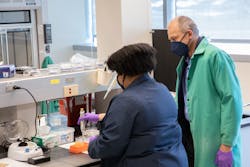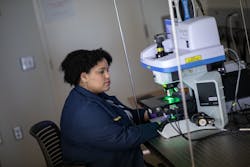DNA is among the most compelling evidence in a crime investigation. But when it isn’t available, or doesn’t exist, investigators must rely on other biological materials to solve a case. Now, researchers in New York are using spectroscopy to make the most of non-DNA evidence.
“We are creating a method for body fluid identification; trace body fluid identification for forensic users,” says Alexis Weber, a Ph.D. student at the University of Albany (UAlbany; New York) and chief operating officer of SupreMEtric, a materials authentication startup founded in 2019 by Igor Lednev, a chemistry professor and lab group leader at UAlbany.
The company developed a nondestructive technique for analyzing biological stains and fluids based on research published in Forensic Science International. Lednev and fellow researcher Kelly Virkler, a chemistry professor at UAlbany, noted in their study that “the ability to characterize an unknown stain at the scene of the crime without having to wait for results from a laboratory” would be a critical step in the development of forensic body fluid analysis.
Originally only used in medical diagnostics, the noninvasive, spectroscopy-based system has also proven effective for forensic science applications (see Fig. 1). It has demonstrated more than 99% effectiveness in detecting and analyzing all main body fluids—all without any destruction to the samples (see Fig. 2). This is particularly valuable for cases in which only a small amount of bodily or other fluids are present at the crime scene. And it could help expedite work on unsolved crimes, bypassing a years-long backlog of DNA samples waiting to be tested and analyzed. Non-DNA evidence can be just as compelling when no DNA samples are available, Weber says.Moving to real-world use
In 2021, SupreMEtric received a U.S. National Science Foundation Phase I Small Business Technology Transfer grant to start bringing the spectroscopy-based system from the lab to clinical, real-world use. Now, the system works with Raman spectroscopy—it uses a confocal Raman spectrometer and laser light to image bodily fluids (see Fig. 3).“When lasers interact with the biologicals, they produce a unique profile that our patented method is able to deconvolute and identify the specific biological sample,” Weber says. The researchers can distinguish between types of fluid based on how the light interacts with the sample.
The Raman spectroscopy system is paired with chemometrics, a data-driven way of extracting information from a chemical system. Chemometrics uses mathematical, statistical, and other methods that use formal logic to take measurements and analyze chemical data and information in a fluid. The pairing of spectroscopy and chemometric analysis enables bodily fluid identification, while also providing additional probative information to investigators.
This could ultimately streamline the work required in the process of analyzing bodily fluids. It could also present a quicker, more efficient way to distinguish fluid types (saliva, blood, etc.) and other characteristics, including the sex, race, and age of the person from whom the fluid originated.
Weber and her team are moving forward with such advancement of the spectroscopy-based system, thanks to a second grant—Phase II funding from the same National Science Foundation Small Business Technology Transfer program that backed the first phase of SupreMEtric’s work.
Making a transition from a university lab discovery to a commercial product is a significant challenge in academia, making grant programs and university backing crucial.
Next steps
This second phase in the project is meant to support the development of a working prototype of the spectroscopy-based system for ultimate commercialization. The next step involves alterations to the system to enhance its efficiency, including creating portable instrumentation for on-site fluid detection and analysis.
“It would be used for rapid analysis at crime scenes, allowing investigators to know what to collect so they’re not collecting trash evidence,” Weber says. “If you get evidence that isn’t well collected or isn’t useful, your results aren’t going to be useful in forensics labs.”
Empowering labs to analyze the most useful biological scenes for testing of DNA as well as body fluids comes with cost savings. “What if someone says, ‘oh, that’s blood, let’s send it for DNA’ testing, but it turns out to be dog’s blood,” she says. “That’s money wasted on testing.”
The new platform will serve as a universal system, where users can analyze evidence without using the actual sample. Currently, no single universal identification and detection technique exists for bodily fluids. And conventional methods are specific to one individual bodily fluid, not all of them.
SupreMEtric plans to work with the New York State Police Crime Lab System and forensic labs as well as instrumentation and software companies to see creation of the market-ready platform to fruition.
“We’re hoping to integrate our product with a Raman spectroscopy company or one that produces Raman spectrometers,” Weber says. The team envisions it as an add-on package or one that’s integrated into hardware.
Advancing their system will still involve a combined Raman spectroscopy/chemometrics method. “While we’ve created a statistical method for the analysis of the sample, we still have to do the Raman spectroscopy process first in the crime labs,” Weber says. “The imaging technique has been used in the past to study and analyze trace evidence, but now it’s evolving. We get to use spectroscopy in a whole new way—for the analysis of biologicals.”
About the Author
Justine Murphy
Multimedia Director, Digital Infrastructure
Justine Murphy is the multimedia director for Endeavor Business Media's Digital Infrastructure Group. She is a multiple award-winning writer and editor with more 20 years of experience in newspaper publishing as well as public relations, marketing, and communications. For nearly 10 years, she has covered all facets of the optics and photonics industry as an editor, writer, web news anchor, and podcast host for an internationally reaching magazine publishing company. Her work has earned accolades from the New England Press Association as well as the SIIA/Jesse H. Neal Awards. She received a B.A. from the Massachusetts College of Liberal Arts.



